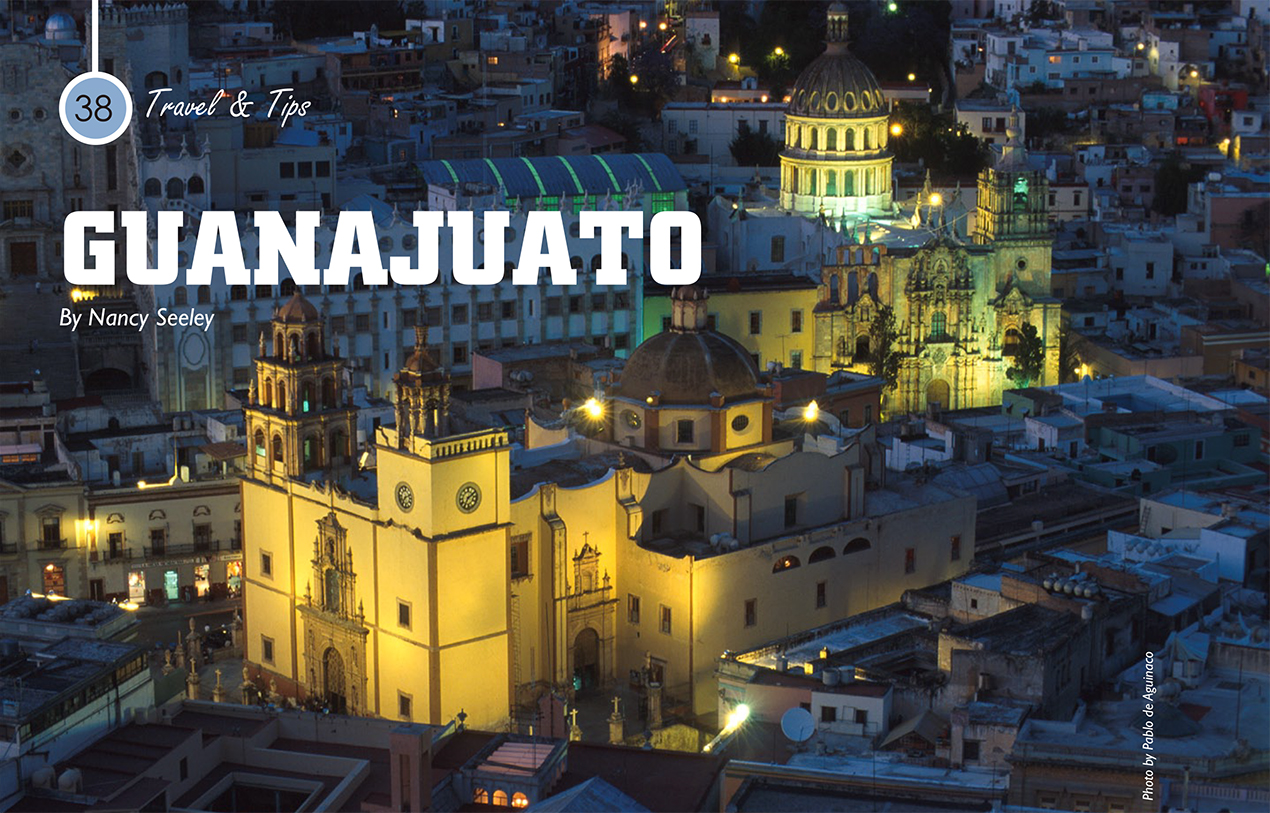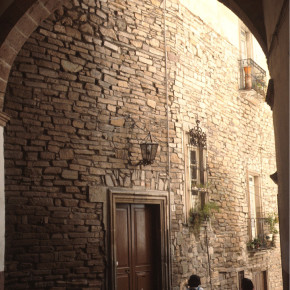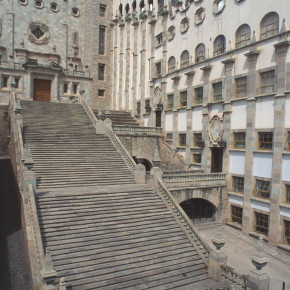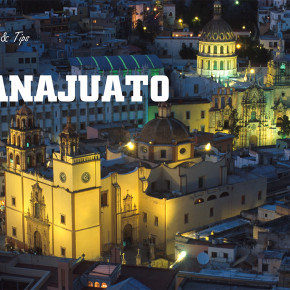 Guanajuato is yet another of Mexico’s impressive collection of colonial cities. Once you’ve been there, though, the subterranean streets running beneath it for about three kilometers guarantee you won’t confuse this old silver mining town with any other. Trivia buffs know, “Once Upon a Time in Mexico,” was filmed here.
Guanajuato is yet another of Mexico’s impressive collection of colonial cities. Once you’ve been there, though, the subterranean streets running beneath it for about three kilometers guarantee you won’t confuse this old silver mining town with any other. Trivia buffs know, “Once Upon a Time in Mexico,” was filmed here.
Originally, the city was built above the Guanajuato River, but discouragingly destructive yearly flooding prompted engineers to redirect the river to underground caverns in the mid-20th century and construct cobblestoned, electrically lighted roadways in its place. One main thoroughfare leads into town, and a second takes you back out again. Exploring is best done on foot in a good pair of walking shoes.
The city is nestled into the Sierra de Guanajuato mountain range and is roughly the same size as Ixtapa-Zihuatanejo, though the two areas could hardly be more different in character. Its name comes from the Tarascan word “quanax-juato,” which means “place of frogs.” Local lore has it that the indigenous population in the 16th century felt their settlement was really only fit for frogs. Given the area’s interesting architecture, cultural diversity, and historical significance, it’s hard to fathom this sentiment today. In 1988, the city became a UNESCO World Heritage site.
Guanajuato abounds in plazas and “callejones” (alleyways). If you’re not careful, you’ll end up back where you started after walking down a steep, winding, narrow cobbled alley, then around a few corners and up a flight of stone steps. My partner, who is generally a whiz at directions, found it difficult to believe how easy it is to get lost in the space of 30 meters. To make it worse, everywhere you went you ended up looking at yet another coat of arms! On the bright side, unless you’re in a big hurry, it’s quite fun getting hopelessly turned around because there’s so much to see no matter where you go.
Because it’s a major university town, you’ll see hundreds of students while walking the downtown streets. They fill the plazas, linger in sidewalk cafes, and sit on the steps of the Teatro Juarez from early morning until late at night. Do take the time to visit this 1903 theater, which faces the city’s main plaza (Jardín de la Unión). A host of life-size statues stand atop the building, and literally every inch of the interior is sculpted, painted, carved and embossed with early 20th century art.
Guanajuato was the birthplace of Diego Rivera and his twin brother (who died at age two), and the home where they were born is now a museum. The largest collection of Don Quixote memorabilia in the world is housed in the Museo Iconográfico del Quijote, which I found especially interesting given that Miguel Cervantes, the Man of La Mancha’s creator, never ventured to Mexico from his native Spain.
Every October, Guanajuato hosts an international Cervantino Festival, which has grown exponentially since its inception and now includes plays, dance performances, concerts, art exhibits, and operas devoted to much more than a remembrance of Cervantes and his work. If you choose to visit the city then, make hotel reservations well in advance and be prepared for higher prices. If you visit Guanajuato late in September (as we did), be prepared for lots of “closed” signs as museums and art galleries ready themselves for the biggest cultural extravaganza of the year.
A major tourist attraction is the Mummy Museum, displaying 111 rather gruesome corpses dug up from a local cemetery where the bodies ended up mysteriously preserved, some say due to a combination of dry atmosphere and a peculiar mineral content in the soil. The grisly remains started being unearthed in 1865 when the cemetery supposedly needed more room for new inhabitants. Those families who couldn’t afford a “burial tax” ended up with their relatives above ground, and new mummies have been added to the collection within the last two decades.
Another grotesque exhibit is the four metal hooks hanging from the four corners of Guanajuato’s famous Alhóndiga de Granaditas, a granary that in 1810 was the site of Mexico’s first victory in her eventually successful war for independence from Spain and is now a history and art museum. From 1811-1821, the cages suspended from those hooks (you can see them inside the building) held the severed heads of four executed war heroes, including the revered Father Miguel Hidalgo, a sobering display of Spanish revenge.
A final comment on that memorable 1810 victory: One of the city’s largest monuments pays tribute to El Pípila, a miner turned soldier who, at Hidalgo’s direction, strapped a slab of rock to his back for protection against Spanish bullets and torched the granary’s gates, killing thousands of enemy troops inside. There’s a funicular you can ride to the huge statue, or you can hike up. Either way, you’ll be rewarded with a panoramic view of this picturesque city, 6,000-plus feet above sea level.
You can take a bus to nearby Valenciana and tour a silver mine which still produces quantities of the precious metal, along with gold, lead and nickel. During part of the 18th century, it is said that one mine in this area was responsible for two-thirds of the world’s silver production! A nearby “must see” is the Iglesia de San Cayetano, a church filled with riches from the mines displayed in intricate Churriqueresque fashion.
If you’re game for yet another bizarre museum, Valenciana boasts one that caters to implements of torture. You leave feeling VERY relieved none of this stuff was ever used on you.
We got to Guanajuato via a night bus from Zihuatanejo to Morelia (about four and a half), a second bus to León (four hours), and a third coach for the final hour to Guanajuato. Counting down time between buses, you can leave at one a.m., sleep along the way, and be heading to your hotel before noon.
There are lots of accommodations options. We were delighted with our rooftop studio apartment at Casa Bertha (300 pesos a night during low season), which afforded a spectacular view of El Pípila. Getting there was half the fun, as the route from our prior digs passed many plazas, wended its way through the university campus, and snaked up some of those narrow callejones before dead-ending at Casa Bertha.
Along the way, we passed El Zopilote Mojado which quickly became my favorite place to hang out for morning coffee and Happy Hour. The name alone – it translates to “The Wet Turkey Vulture” – demanded an initial visit.
There’s so much more to see and do. Check out www.guanajuato-travel.com or www.guanajuato.gob.mx to get started. If computers aren’t your thing, then head to the downtown tourist office at Plaza de la Paz once you get there. Whether you want to be steeped in history, surrounded by students, staggered by the sheer volume of cultural opportunities or stimulated by the natural beauty of Guanajuato, there’s something for everyone in this colonial gem.






